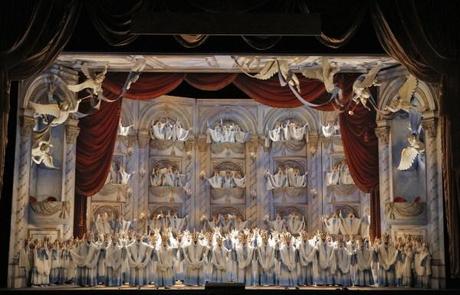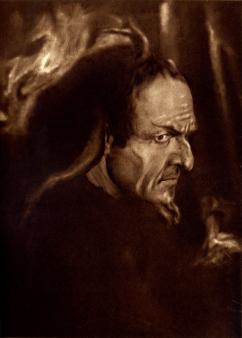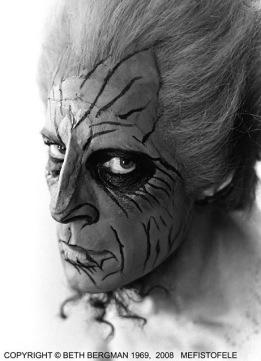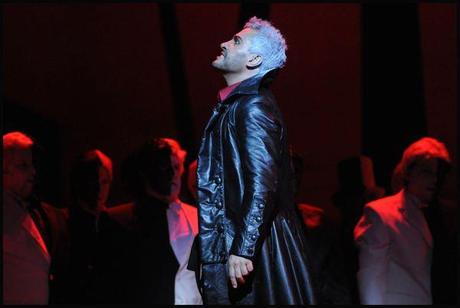The Pros and the Cons

San Francisco Opera Chorus in the Prologue to Mefistofele (stageandcinema.com)
And what an opera Mefistofele is! Bold, bombastic, episodic, quirky, lyrically stimulating, melodious and tearful, frustrating, visionary, intellectually and academically cold, musically satisfying — these are but a few of the adjectives used to describe what some critics have termed a tedious and perfunctory affair on the stage when improperly done.
In the same breath, in a version that does justice to the work’s expressive power and epically inspired proportions, Mefistofele can raise the rafters as few operas can. What’s more, with a dynamic and dedicated cast of singing-actors it can surpass audience’s expectations to become one of the most thrilling and uplifting experiences the theater has to offer.
When talk eventually turns to Boito’s lone operatic masterwork, most fans wax nostalgic over Tito Capobianco’s sumptuous 1969 conception at New York City Opera, with bass-baritones Norman Treigle and Samuel Ramey (in a later 1978 revival) sharing titular duties, and conductor Julius Rudel as the driving force behind it all. The Met Opera’s current production, originally slated for San Francisco and directed by Robert Carsen, while not up to the standards of its illustrious NYCO predecessor — it’s a bit too self-indulgent and over-the-top for my taste — does offer tremendous opportunities for performers to shine.
As if on cue, several back-to-back re-hearings, first at San Francisco Opera on opening night, in September 2013, with Ildar Abdrazakov as the Devil, Ramón Vargas as Faust and Patricia Racette as Margherita and Helen of Troy; then at Carnegie Hall, in a November 2013 concert performance featuring Eric Owens, Arturo Chacón-Cruz, Juliana Di Giacomo and the Collegiate Chorale, have reignited interest in staging this most challenging of Italian works.
Why all the hullaballoo over Lucifer then? Have we been systematically hypnotized by the power of Beelzebub, lulled into action at His Satanic Majesty’s request? Well, not exactly. The work, at least in this over lover’s mind, has always been at the forefront (if not skirting the fringes) of the standard repertoire. With all due respect to its critics, Mefistofele served as the basis for several important artists’ debuts, among them tenor Beniamino Gigli as Faust in virtually all the major opera houses in his native Italy, as well as at the Met (on November 26, 1920) and elsewhere.

Chaliapin as Mefistofele in 1910
Similarly, the renowned Russian basso Fyodor Chaliapin made a veritable calling card out of the title part with his initial entry into La Scala, Milan in 1901, which he also repeated on November 20, 1907, at the Metropolitan Opera (by some quirk of fate, November seems to be the month for Mefistofele), alongside American soprano Geraldine Farrar. Here is what music critic W.J. Henderson, of the New York Sun, wrote of Chaliapin’s Devil:
“He is an elemental creature, roaring and champing like a bull, charging the poor sinners of this world with the fuss and energy of a 60 horse-power motor and leaving a trail of fire and brimstone behind him. This is the Satan resulting from the union of the Italian creator and Russian interpreter. His frame, gigantic as it is, cannot contain his nature. He writhes with the emotions that convulse him. His face is drawn into expressions of the profoundest agony… All the dramatic action tending to establish this conception of Boito’s Satan is accompanied by every helpful aid of light, scenery and mechanical ingenuity. Mr. Chaliapin takes the utmost pains with his make-up, which combines effectively the use of fleshlings and bare skin.”
It was this aspect of the singer’s performance, this baring of his flesh — or more specifically, Chaliapin’s rump — that got the star in trouble with the Met’s prudish Diamond Horseshoe set; those fabulously wealthy patrons of the arts (to include the daughter of banker J.P. Morgan) so easily scandalized by Strauss’ Salome, which had its New York debut in January of the same year, that they forced all subsequent performances of that work to be canceled. Salome was not heard at the Met until 1934. Positively scandalous!
Remarkably, while Mefistofele survived more or less halfhearted attempts to vilify it, yet remained in the Met’s repertoire through 1926 — along with being interpreted by a string of great artists, including basses Édouard de Reszke, Pol Plançon, the aforementioned Chaliapin, and Adamo Didur and José Mardones after him — it unaccountably vanished from the house for 73 seasons until the 1999 Carsen production with Ramey brought it back to prominence. At present, the Met has issued plans to resurrect this particular staging for the 2015 and 2017 seasons.
Prologue: “Holy, Holy, Holy”
Digging deep into Boito’s version of the Faust story is the equivalent of taking Goethe’s poem off its Romantic pedestal and placing it on the next lowest rung of the operatic ladder. It begins very much as Goethe’s play instructs, with a Prologue in Heaven. Impressive horn and brass fanfares inform us that we are in the nebulous regions of space, in addition to announcing the mystical presence of the Heavenly Host. In deference to the German poet’s dramatic sense, the fanfares reappear at strategic points in the drama, most forcefully near the end.
This segues directly into a lovely celestial paean, “Ave Signor,” in praise of the Lord and His angels. The chorus’ full-voiced entreaties, joined by those of earthly penitents and cherubic children’s choir, is unleashed right at the outset, which serves to prepare listeners for their combined glories later on. After this opening passage, a sprightly orchestral introduction (or scherzo istrumentale) brings forth Mefistofele, God’s fallen angel in devilish guise, who seizes the opportunity to mock the heavenly choir’s hymn of praise:
Hail Lord of Heaven!
Pardon me if my jargon
falls a bit short
of the sublime anthems of Paradise;
Pardon me, too, if my countenance
does not beam with the rays
that garland the golden tresses
of the highest cherubim!
These exaggerated expressions of approbation continue on in this vein, until the Devil decides to conclude his sardonic tirade by admitting he no longer has the heart to tempt man to do evil, so frail and feeble a specimen he is. Flutes, piccolo and bassoon, flitting about airily in the orchestra, underscore Satan’s cutting remarks, a musical showing of the tongue as it were.
Hinting at the philosophical theme of the work, the Mystical Choir (standing in for the Lord of Hosts) hurls a question at Mefistofele: “Do you know Faust?” After the trombones intone a portentous reprise of the opening fanfare, Mefistofele responds in kind: “The most fantastical madman I know,” then goes on to describe the fellow’s unquenchable thirst for knowledge, which only “makes him more anxious and miserable”:
He strives to go beyond the reach of man,
And no science can satisfy his gloomy thoughts
In a flash of malevolent insight, Mefistofele poses a challenge to the Maker: “I’ll take it upon myself to seduce this creature and ensnare him in my net; would you like to wager on the outcome?” “So be it!” proclaims the Heavenly Host. Mefistofele echoes their acceptance of the bargain and throws in a few pearls of his own: “So be it! Old Maker, you have embarked on a dangerous game.” Inflicting the same warped logic on God as the Serpent once used on Eve, Mefistofele gloats that Faust will bite of the sweet apple of vice, but that he, the Devil, shall taste the ultimate victory!
“Sanctus, Sanctus, Sanctus!” (“Holy, Holy, Holy”) cries the Mystical Choir. Not wanting to belabor the point, Mefistofele retreats to a neutral position and assumes a less confrontational stance vis-à-vis the Lord: “From time to time, I enjoy engaging in these little pleasantries with the Old Man, taking care not to upset our fine relationship.” He then tosses in a sarcastic jab:
È bello udir l’Eterno
col Diavolo parlar sì umanamente
It’s great to hear the Eternal
Converse so humanly with the Devil

Norman Treigle as Mefistofele (Photo: Beth Bergman, 1969, 2008)
In Norman Treigle’s EMI/Angel recording of this sequence, the late bass defiantly spat out the words “È bello,” after savoring every ironic twist and turn; on the other hand, Samuel Ramey, in his live Met Opera performances of the same piece, would place the phrase in the most cavernous part of his voice (taking the alternate low notes), while practically regurgitating onstage at the words “sì umanamente,” which made the audience howl with glee.
There have been many powerful performances of the Devils’ portion of the Prologue, not only by the above-named talents but by the Italian Cesare Siepi and Bulgarian Nicolai Ghaiurov as well. While all these fine artists worked within the parameters of “Mefistofele as the Evil One” incarnate, another worthy contender, Uruguayan bass-baritone Erwin Schrott, took a slightly different turn, a more lighthearted, even whimsical approach to the part. His rendition of the scene, during the 2012 Richard Tucker Gala in New York, is filled with clever flourishes and novel touches of characterization: for instance, that marvelous black-leather jacket Schrott sports to the platform, a truly satanic prop; and the all-important body language he employs to provoke more than to challenge the Lord to action.

Erwin Schrott as Mefisto in Monaco (visitmonaco.com)
All this would be for naught, were it not for the way Schrott uses his voice to create a viable personality. Note how he gives due stress and substance to Boito’s text by never forcing the notes, by simply lingering on certain key phrases (“Ei morderà nel dolce pomo de’ vizi” is a case in point), while sustaining a jovial air of good humor throughout. Schrott also gives off a welcome sex appeal and self-assured swagger. In fact, his devil is so sure of himself that he doesn’t need to bargain: this fallen angel is obviously at the top of his game… for now. He just knows, instinctively, that Faust hasn’t got a chance; that the Lord will be forced to ante up in the end.
The cherubim now chime in, singing their monotonous patter to the Devil’s annoyance (“How they buzz like a swarm of bees”). He leaves the scene to the earthy penitents below, who are accompanied by the organ and sung by the women’s choir. They chant a solemn “Salve Regina” (“Hail Queen of Heaven”) over the childish prattle of the cherubs, as the men of the Heavenly Host return with their prayerful invocation to God. The disparate choruses merge as one in a reiteration of the hymn of praise that began the Prologue.
The din rises to an almost unbearable climax with fanfares of trumpets and brass blazing forth from every part of the auditorium, the penitents and Heavenly Host joining with the cherubim and organ in a mighty “Hail to You, Oh Lord,” as the entire assemblage comes to a glorious crescendo on a triumphant, long-held note: “Ave, Ave!”
Clearly Arrigo Boito, who worked as the librettist for Verdi’s Otello and Falstaff, may have also inspired the Italian master’s composition of the Requiem Mass, which came not six years after Mefistofele’s disastrous debut. As previously noted, Boito revised his opera, cutting out whole sections and destroying what remained. Though both men were fervently anti-religious, with the agnostic Verdi the more earnest of the two, each in turn drew sustenance from Roman Catholicism when it served their purpose, which Boito’s Prologue to Mefistofele most decidedly did.
(End of Part Two – To be continued…)
Copyright © 2014 by Josmar F. Lopes

